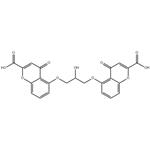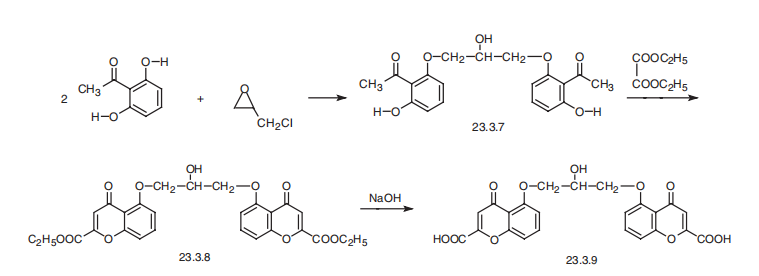- Cromoglicic acid
-

- $8.00 / 1KG
-
2024-03-29
- CAS:16110-51-3
- Min. Order: 1KG
- Purity: 99%
- Supply Ability: g-kg-tons, free sample is available
- Cromoglicic acid
-

- $1.00 / 1g
-
2021-07-20
- CAS:16110-51-3
- Min. Order: 1g
- Purity: 99%
- Supply Ability: 50tons
Related articles - Uses of Cromolyn
- Cromolyn is a synthetic analog of the plant extract khellin that was first developed in the late 1960s and introduced into cli....
- Jan 12,2022
|
| | Cromoglicic acid Basic information |
| Product Name: | Cromoglicic acid | | Synonyms: | 1,3-bis(2-carboxychromon-5-yloxy)-2-hydroxypropane;cromoglicic acid;CROMOGLYCATE SODIUM SALT;cromoglycic acid;CROMOGLYCIC ACID SODIUM SALT;CROMOLYN;CROMOLYN SODIUM;CROMOLYN SODIUM SALT | | CAS: | 16110-51-3 | | MF: | C23H16O11 | | MW: | 468.37 | | EINECS: | 240-279-8 | | Product Categories: | Pharmaceutical | | Mol File: | 16110-51-3.mol |  |
| | Cromoglicic acid Chemical Properties |
| | Cromoglicic acid Usage And Synthesis |
| Description | Cromolyn is a synthetic analog of the plant extract khellin that
was first developed in the late 1960s and introduced into
clinical practice the following decade. It is continued to be used
widely in the treatment of allergic rhinitis, asthma, mastocytosis,
and conjunctivitis. It has an outstanding safety profile
and can be readily obtained without prescription in many
countries. | | Originator | Intal,Fisons,UK,1969 | | Uses | Cromolyn is used primarily for the prophylaxis of various types
of asthma and in the treatment of allergic rhinitis, mastocytosis,
and vernal conjunctivitis. | | Uses | It is used for bronchial asthma, as well as prevention of seasonal, constant, and physically
caused asthma attacks and allergic rhinitis. | | Uses | Anti Asthamatic | | Definition | ChEBI: A dicarboxylic acid that is the bis-chromone derivative of glycerol. It is effective as a mast cell stabilizer. | | Manufacturing Process | To a solution of 970 parts of 2,6-dihydroxyacetophenone and 325 parts of
epichlorohydrin in 1,500 parts of hot isopropanol was added, with stirring under reflux, a solution of 233 parts of 85% KOH in 2,500 parts of
isopropanol and sufficient water (ca 100 parts) to dissolve the solid. The
mixture was heated, with stirring, under reflux for 48 hours. Half the solvent
was then distilled off and 5,000 parts of water were added. The mixture was
cooled and the solid filtered off and washed with isopropanol and ether. It was
then recrystallized from 12,500 parts of isopropanol to obtain a first crop of
380 parts and a second crop, after concentration, of 300 parts of 1,3-bis(2-
acetyl-3-hydroxyphenoxy)-2hydroxypropane.
4.6 parts of 1,3-bis(2-acetyl-3-hydroxyphenoxy)-2-hydroxypropane were
reacted with diethyl oxalate and the product cyclized to obtain 4.4 parts of
pure diethyl ester of 1,3-bis(2-carboxychromon-5-yloxy)-2-hydroxypropane as
pale yellow crystals melting between 180° and 182°C from a mixture of
benzene and petrol, 4 parts of the diethyl ester of 1,3-bis(2-carboxychromon5-yloxy)-2-hydroxypropane were saponified with sodium hydroxide to obtain
3.2 parts of the disodium salt tetrahydrate as colorless crystals from aqueous
alcohol. | | Therapeutic Function | Bronchodilator | | General Description | Solid. | | Air & Water Reactions | Water soluble. | | Reactivity Profile | Carboxylic acids donate hydrogen ions if a base is present to accept them. They react in this way with all bases, both organic (for example, the amines) and inorganic. Their reactions with bases, called "neutralizations", are accompanied by the evolution of substantial amounts of heat. Neutralization between an acid and a base produces water plus a salt. Carboxylic acids in aqueous solution and liquid or molten carboxylic acids can react with active metals to form gaseous hydrogen and a metal salt. Such reactions occur in principle for solid carboxylic acids as well, but are slow if the solid acid remains dry. Even "insoluble" carboxylic acids may absorb enough water from the air and dissolve sufficiently in Cromoglicic acid to corrode or dissolve iron, steel, and aluminum parts and containers. Carboxylic acids, especially in aqueous solution, also react with sulfites, nitrites, thiosulfates (to give H2S and SO3), dithionites (SO2), to generate flammable and/or toxic gases and heat. | | Fire Hazard | Flash point data for Cromoglicic acid are not available. Cromoglicic acid is probably combustible. | | Mechanism of action | Cromolyn stabilizes the membranes of mast cells, stopping the release of allergy mediators
and suppressing activation of eosinophiles, neutrophilis, thrombocytes, and
macrophages, which take part in the formation of bronchospasms.
Cromylyn differs from the majority of medications taken for obstructive diseases of the
respiratory tract in that it is used only as a preventative agent. | | Clinical Use | Cromolyn generally is used prophylactically for bronchial asthma (as an inhaled powder), for
prevention of exercise-induced bronchospasm, and for seasonal and perennial allergic rhinitis
(nasal solution). Topically, it also is used as eye drops for allergic conjunctivitis and keratitis.
In
the management of asthmatic conditions, it is administered using a power-operated nebulizer.
The bioavailability is very low with oral administration because of poor absorption. By
inhalation, the powder is irritating to some patients. After inhalation, much less than 10% of
the dose reaches the systemic circulation. An oral dosage form is used for mastocytosis. | | Synthesis | Cromolyn, 5,5�[(2-hydroxytrimethylen)dioxy] bis 4-oxo-4H-1-benzopiran-2-
carboxylic acid (23.3.9), are synthesized by reacting 2,6-dihydroxyacetophenone with
epichlorohydrine, during which the chlorine atom in epichlorohydrine is replaced and an
opening of the epoxide ring takes place, resulting in a bis-product 23.3.7. Cyclization of
this product into a bis-derivative 23.3.8 is accomplished using diethyloxalate, subsequent
alkaline hydrolysis of the ester groups of which gives the desired cromolyn (23.3.9). 
| | Environmental Fate | The major prophylactic effect of cromolyn is centered on
inhibition of the degranulation of pulmonary mast cells
causing a reduction in histamine release, reduced leukotriene
production, and inhibition of release of inflammatory mediators
from several cell types. | | Toxicity evaluation | Cromolyn is a mast cell stabilizer and typically marketed as the
sodium salt in the United States. It is typically found in solution
as a clear and colorless liquid. Cromolyn is soluble in
water and the solution is completely soluble in water. |
| | Cromoglicic acid Preparation Products And Raw materials |
|